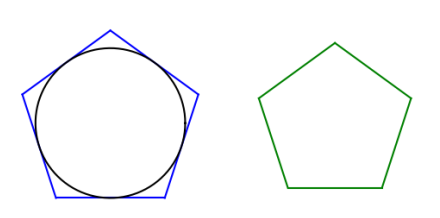Galileo’s polygon theorem
William J. Milne [1] attributes the following theorem to Galileo:
The area of a circle is a mean proportional between the areas of any two similar polygons, one of which is circumscribed about the circle and the other is isoparametric with the circle.
So imagine a polygon P and let S be an inscribed circle, that is, the largest circle that can fit inside P. Also imagine a second polygon P the same shape as P but with perimeter equal to that of S. Then the ratio of the area of P to the area of S equals the ratio of the area of S to the area of P. Said another way, the area of S is the geometric mean between the areas of P and P.

In the figures above, the blue pentagon is P, the black circle is S, the green pentagon is P, and S and P have the same perimeter.
Clearly the blue pentagon has a greater area than the black circle. The isoparametric theorem says that a circle has the maximum area for a given perimeter, so the black circle must have larger area than the smaller pentagon. This doesn't prove Galileo's theorem, but it does prove that at least the area of the circle is somewhere in between the areas of the two pentagons.
You can prove Galileo's theorem for regular n-gons using the formulas in this post and one other fact: the ratio of the radii of inscribed and circumscribed circles sandwiching a regular n gon is cos(/n).
[1] William J. Milne. Plane and Solid Geometry. 1899. p. 377, exercise 135.
The post Galileo's polygon theorem first appeared on John D. Cook.